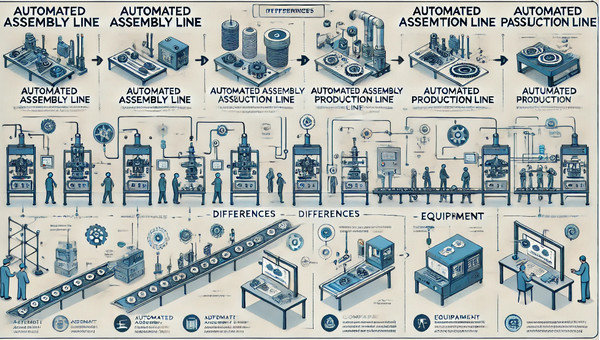News
News

An automated assembly line is a production system that uses mechanical, electronic, and computer control systems to automatically assemble individual components into finished products. Its core principle is to break down the assembly process of each unit into several operations and connect these operations through conveyors, robotic arms, and other equipment to achieve continuous production. Automated assembly lines are widely used in the automotive, electronics, and electrical appliance manufacturing industries.

Clear Division of Labor: Each workstation focuses on a specific assembly task, ensuring standardized and consistent production processes.
Continuous Operation: Utilizing a conveyor system, all working stages are tightly connected, reducing intermediate downtime and increasing production efficiency.
Automated Control: Using PLCs, sensors, and other automated control systems to achieve precise production scheduling and quality control.
Flexible Production: Capable of meeting the needs of multi-variety and small-batch production by adjusting and switching production modes to cater to diverse market demands.
An automated assembly line is a production system specifically designed to automatically assemble multiple parts into modules or sub-assemblies. Unlike automated assembly lines, assembly lines focus more on unit combination and modular production and are often used in the early stages of production.
Modular Design: The assembly line consists of multiple independent assembly units that can be flexibly adjusted and configured according to production needs.
Precision Assembly: Utilizing advanced assembly technology and equipment to ensure assembly accuracy and quality.
High Flexibility: Capable of meeting various product assembly requirements and quickly switching assembly tasks.
Collaborative Operation: Assembly units coordinate through an intelligent control system, achieving efficient production rhythm.
Automated Assembly Lines: Focus on the final assembly of individual components into finished products, suitable for products with longer production cycles and complex processes.
Automated Assembly Lines: Focus on assembling parts into modules or sub-assemblies, suitable for early-stage production and modular production.
Automated Assembly Lines: The entire production process includes multiple stages, from component assembly, inspection, debugging to final product packaging.
Automated Assembly Lines: Primarily focused on the assembly process of parts, with a relatively simplified process.
Automated Assembly Lines: Equipped with more conveyors, robotic arms, inspection devices, etc., making the system complex and the investment high.
Automated Assembly Lines: Equipment configuration is relatively simple, mainly focused on assembly units and control systems, with lower investment.
Automated Assembly Lines: Designed for specific products, with lower flexibility and requiring significant modifications to adapt to different product production.
Automated Assembly Lines: Modular design, high flexibility, and capable of quickly adapting to different product assembly requirements.
In automobile manufacturing, automated assembly lines are widely used in the assembly process of entire vehicles. For example, the assembly of engines, transmissions, and car bodies relies on automated assembly lines to achieve efficient and precise production, ensuring product consistency and quality.
In electronics manufacturing, automated assembly lines are commonly used for the assembly of circuit boards and electronic modules. For example, in the assembly process of products like mobile phones and computers, automated assembly lines facilitate the fast and high-precision assembly of various electronic components, enhancing production efficiency and product quality.
Automated assembly lines and automated assembly lines play important roles in modern manufacturing. Each has its own focus, but both aim to enhance production efficiency and product quality through automation technology. Understanding their differences helps enterprises choose the appropriate production system according to their needs, achieving efficient production and competitive advantage.
Copyright © Shenzhen City Huya Technology Co., Ltd. All Rights Reserved Sitemap | Powered by XiaoLiang